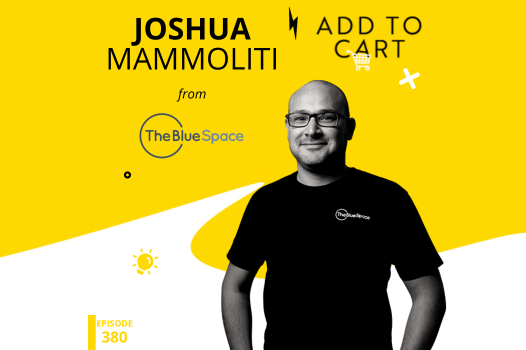In this episode of Add To Cart, we are joined by Joshua Mammoliti, Founder and CTO at The Blue Space
The Blue Space is Australia’s largest pureplay online renovation retailer. With a background in digital working for leading Australian bathroom & kitchen brands like Caroma, Josh saw an opportunity for ecommerce innovation at a time when very few in the industry agreed. Eight years later, The Blue Space is well established and an online leader in the bathware category. Josh himself has been recognised by making the 2023 Top 50 People in eCommerce list. Josh shares the unique delivery needs of the renovator, the AI customer service tool that is head and shoulders above anything else he’s got and we hear the valuable lessons learned from The Blue Space’s recent systems implementation. Was it all worth it? We find out.

“I think we’ll start to move into a territory where the experience online is actually better than a showroom”
Joshua Mammoliti
The last 5%
“I think the moment for me, I was in the warehouse, I think it might have been 11 o’clock at night. I’d worked all day in the business trying to keep things running and then I did a six-hour shift in the warehouse, just to try and help them pick and pack the orders. I think 11 o’clock at night it was myself and Trevor, someone else out there with me. And we were just like, we can’t do anymore. We can’t see numbers anymore. And we still had a pile of paper orders, there’d at least be a hundred orders we didn’t get to that were now likely going to be late because we just could not physically get to it.
And it was probably that moment there that I realised we can’t run the business like that if we’re thinking of scaling. And obviously COVID was a very one-off boost in the business but our vision has always been to be to be the leading player in this space. We want to be the biggest and to get there we had in that moment, we knew to be that big a business would need better platforms that we could customise. And I think for any e-comm business, I’m sure many of your listeners get 95% of what you want out of an off-the-shelf tool. And we had exactly that, we had 95% of what we needed.
All the plug and play systems were covering 95%. But it’s that last 5% that really makes a difference. And you just can’t get there unless you have a system where you can build what you want at the end of the day.”
Better than a showroom
“We’ve built a visualization tool that basically builds a vanity from scratch. So you make your selection and it builds a very realistic and I mean really, really realistic image or I think it’s about six images it produces of the actual vanity. And to give you an idea where that kind of sprouted from was again the UK. I was checking out some wardrobe companies in the UK and they’ve got these really cool wardrobe builders where you can make their selections and see this very customizable wardrobe. And when I dove into the tech a bit more, I realised that all they did was render every single permutation of a wardrobe as a static image. And then every time you pushed a button, it just changed the image.
So we realised we had to build something a bit different. And when we first built it, it was quite slow, but with the kind of the new tech around GPUs and the new way of processing information, we’ve managed to get that down. So I think it’s four to five seconds now, make your selection, four to five seconds later, we can show you some really high quality rendered images. So we launched something, the tech works, we know the tech works, we’ve kind of done the hardest part.
And now we’re rebuilding the interface to make it a bit easier to use. So that really excites me. So I think once you can visualise a highly customised product like that, then we move into visualising whole rooms. And I think that’s where we’ll start to move into a territory where the experience online is actually better than a showroom. So it’s not just matching a showroom anymore. It may become the
preferred way to do things. People may prefer to do it online because it actually is better. No showroom could show every single option about it. They’re very limited on space, they’re huge products, but we can online show every single permutation.”
Offset costs
“Our return rate is really low. I think it’s less than half a percent, which we’re really happy with. But if a customer needs to return something when they’ve got a tradesperson on site, it just becomes such a costly exercise for them.
So it’s not just the pain of getting back something big and bulky to us and the costs and the environmental impact that comes with that as well. They usually have a tradesperson standing there saying, you’ve bought the wrong thing. That’s your problem, not mine. I’m still giving you a bill for this half an hour that I’m standing here looking at the wrong product. So it can really blow out.
So we do everything we can to educate the customers before they purchase and make sure they’ve got the right thing. So that we can avoid that for them. We’re saving on rent, so high street rent that you’re potentially paying for a showroom, staffing those shows. But definitely, we see those as things that we just have to do to bridge that gap.”
Links from the episode:
This episode was brought to you by…




